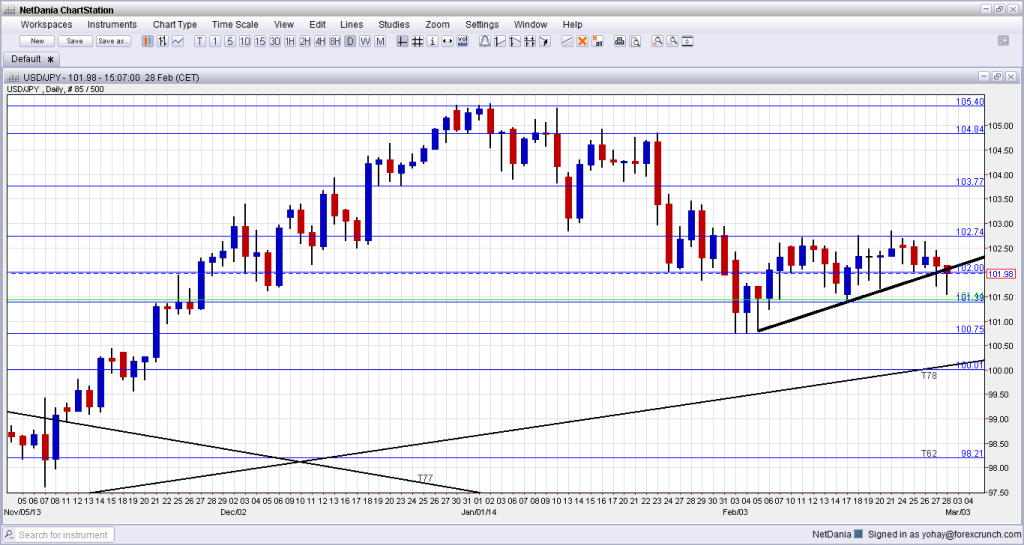The Japanese yen enjoyed worries about Ukraine and unimpressive US data to slide. A wide variety of indicators is due to impact the yen. Here is an outlook on the major market-movers and an updated technical analysis for USD/JPY.
Japan recorded another win over deflation, with improvements in all inflation figures. However, the road is still long, especially given the upcoming tax hike. US indicators were mixed, with strong durable goods orders and new home sales, while jobless claims rose. This weighed on USD/JPY that struggled with the strong 102.70 line and eventually fell to lower ground. The downwards US GDP revision, even though there were caveats, didn’t help either. Also the events in the Ukraine, which is torn between east and west, triggers safe haven flows towards the Japanese yen.
[do action=”autoupdate” tag=”USDJPYUpdate”/]USD/JPY graph with support and resistance lines on it. Click to enlarge:
- BSI Manufacturing Index: Sunday, 23:50. Early in the week, we get two important indicators. This survey of large companies in the manufacturing sector has been positive in the past three quarters, indicating optimism. The official data is expected to tick up from 9.7 seen in Q4 2013 to a double digit figure in Q1 2014.
- Capital Spending: Sunday, 23:50. The level of capital spending grew by 1.5% in Q3 2013. A somewhat slower growth rate is expected for Q4 2013, especially after the weak GDP value.
- Monetary Base: Monday, 23:50. Since the Bank of Japan announced its grand plan in April 2013, the monetary base seen large year on year growth rates. After a growth rate of 51.9% in February, an even higher growth rate is expected now, given the stronger conviction of the BOJ to act to curb the effect of the sales tax hike.
- Average Cash Earnings: Tuesday, 1:30. The Japanese government would like to see higher wages in Japan, and thus a higher pace of inflation and a stronger economy. After a rise of only 0.5% in December, a stronger rise is expected for January.
- BOJ Monthly Report: Friday, 5:00. The Bank of Japan releases the documents it uses for its monetary policy decisions. The recent report showed optimism, and this one is expected to continue the same line.
- Leading Indicators: Friday, 5:00. This is also an official government figure, that combines no less than 11 indicators. Steady rises have been seen in this compound figure, reaching a peak of 112.1% for the month of December. A small drop could be seen for January.
* All times are GMT.
USD/JPY Technical Analysis
Dollar/yen began the week trading in a perfect range (mentioned last week) of 102.74 to 102, testing both ends and remaining in range. It eventually fell to lower ground reaching a low of 101.55 before slightly recovering.
Technical lines from top to bottom
The top line is the peak seen in the turn of the year: 105.44. This was challenged several times. Below, 104.80 capped the pair during January.
Below, 103.77 provided support for the pair in January and served as a clear separator of ranges. 102.74 was a stubborn peak during February and is the top line of the current trading range.
102 is a round number that provided support to the pair in late January and is now a pivotal line in the range.
101.35 replaces the previous peak of 101.44 after working as support in February. 100.75 was a cushion for the pair during several days earlier in the year and is the last defense before the very round number.
100 is the ultimate support line and the last line for now.
I turn neutral on USD/JPY
While the long direction of the pair remains to the upside due to tightening intentions of the Fed, (and the downwards GDP revision does not change this) and easing intentions of the BOJ, two global issues are pushing safe haven flows towards the yen: the volatile situation in the Ukraine and the worries about the Chinese economic strength, which are reflected in a process of a weakening of the yuan. So, the long term rise is balanced by short term headwinds.
More on Dollar/yen:
Further reading:
- For a broad view of all the week’s major events worldwide, read the USD outlook.
- For EUR/USD, check out the Euro to Dollar forecast.
- For GBP/USD (cable), look into the British Pound forecast.
- For the Australian dollar (Aussie), check out the AUD to USD forecast.
- For USD/CAD (loonie), check out the Canadian dollar forecast.
- For the kiwi, see the NZDUSD forecast.

